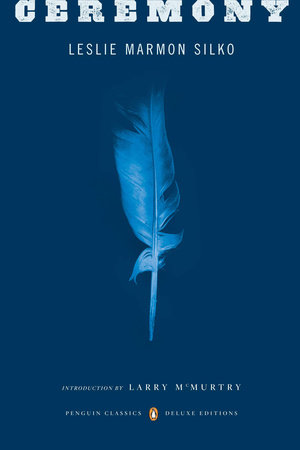Ceremony Reader’s Guide
By Leslie Marmon Silko


INTRODUCTION
Tayo, the hero of Leslie Marmon Silko’s groundbreaking novel Ceremony, is a half-blood Laguna Indian who returns to his reservation after surviving the Bataan Death March of World War II. As he struggles to recover the peace of mind that his experience of warfare has stolen from him, Tayo finds that memory, identity, and his relations with others all resemble the colored threads of his grandmother’s sewing basket. The elements of his personality feel knotted and tangled, and his every attempt to restore them to order merely snags and twists them all the more. Tayo’s problems, however, extend far beyond the frustrations and alienation he encounters in trying to readjust to peacetime. Having risked his life for an America that fundamentally disowns him, Tayo must confront difficult and painful questions about the society he has been fighting for.
In the pages of Ceremony, a novel that combines extraordinary lyricism with a foreboding sense of personal and national tragedy, Leslie Marmon Silko follows Tayo as he pursues a sometimes lonely and always intensely personal quest for sanity in a broken world. As Tayo searches for self-knowledge and inner peace, the reader, too, embarks on a complex emotional journey. In observing Tayo’s efforts to come to terms with a society that does not fully acknowledge his humanity, one may initially feel personal sympathy with his character. However, as Silko’s narrative steadily metamorphoses into an indictment of social and historical forces that have led to Tayo’s suffering, the reader’s feelings are likely also to transform, as simple pity gives way to solemn contemplation of the atrocities that our native peoples have been forced to undergo.
As powerful as Tayo’s story is, the enduring triumph of Ceremony extends far beyond its narration of events. Interwoven into the tale of Silko’s hero, giving structure to the novel and added meaning to its insights, are the ancient stories of the Laguna people—stories that explore the nature of magic, that delve into the origins of evil, and that may also point a way toward purification and redemption. Silko’s reader discovers that she or he is, indeed, taking part in a mystic ceremony—an initiation into a new way of thinking and feeling. Both tenderly humanistic and apocalyptically prophetic, Ceremony is truly a novel capable of changing both hearts and minds.
Leslie Marmon Silko was born in 1948 to a family whose ancestry includes Mexican, Laguna Indian, and European forebears. She has said that her writing has at its core “the attempt to identify what it is to be a half-breed or mixed-blood person.” As she grew up on the Laguna Pueblo Reservation, she learned the stories and culture of the Laguna people from her great-grandmother and other female relatives. After receiving her B. A. in English at the University of New Mexico, she enrolled in the University of New Mexico law school but completed only three semesters before deciding that writing and storytelling, not law, were the means by which she could best promote justice. She married John Silko in 1970. Prior to the writing ofCeremony, she published a series of short stories, including “The Man to Send Rain Clouds.” She also authored a volume of poetry, Laguna Woman: Poems, for which she received the Pushcart Prize for Poetry.
In 1973, Silko moved to Ketchikan, Alaska, where she wrote Ceremony. Initially conceived as a comic story abut a mother’s attempts to keep her son, a war veteran, away from alcohol, Ceremony gradually transformed into an intricate meditation on mental disturbance, despair, and the power of stories and traditional culture as the keys to self-awareness and, eventually, emotional healing. Having battled depression herself while composing her novel, Silko was later to call her book “a ceremony for staying sane.” Silko has followed the critical success of Ceremony with a series of other novels, includingStoryteller, Almanac for the Dead, and Gardens in the Dunes. Nevertheless, it was the singular achievement of Ceremonythat first secured her a place among the first rank of Native American novelists. Leslie Marmon Silko now lives on a ranch near Tucson, Arizona.
Just for joining you’ll get personalized recommendations on your dashboard daily and features only for members.
Find Out More Join Now Sign In